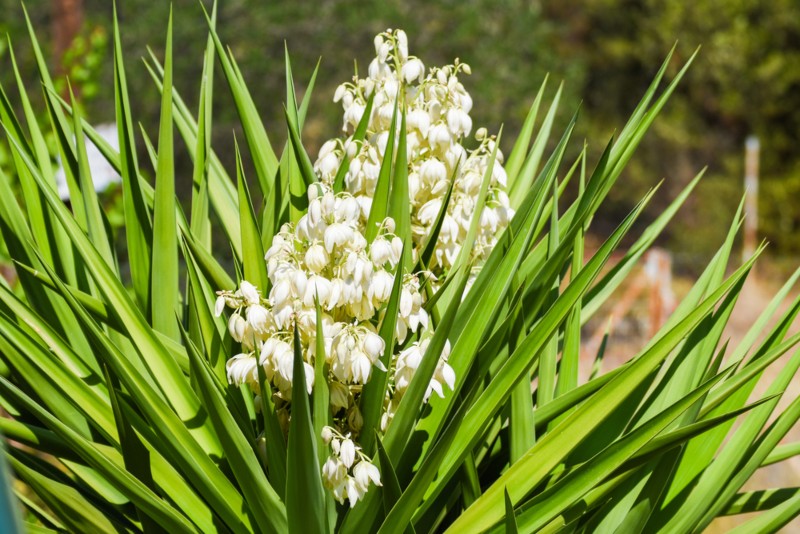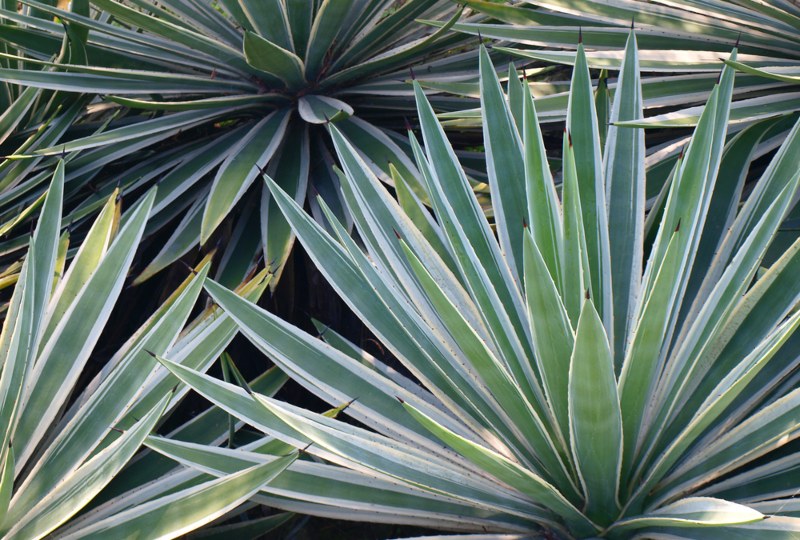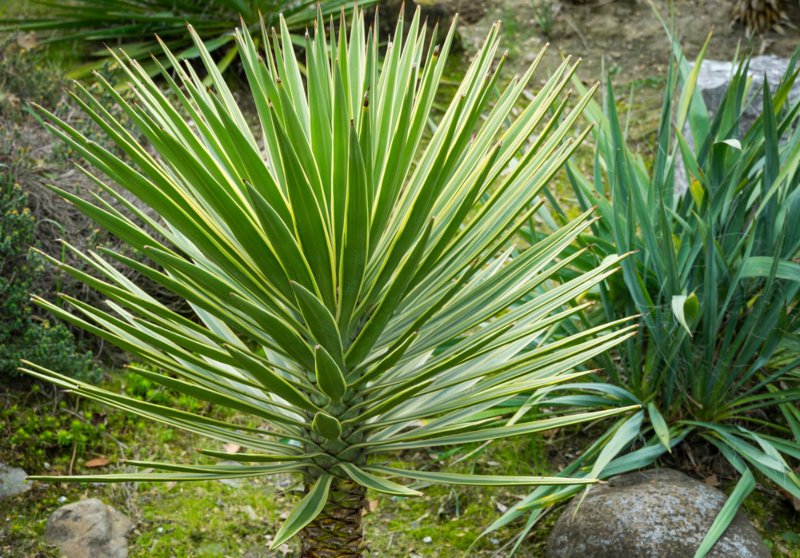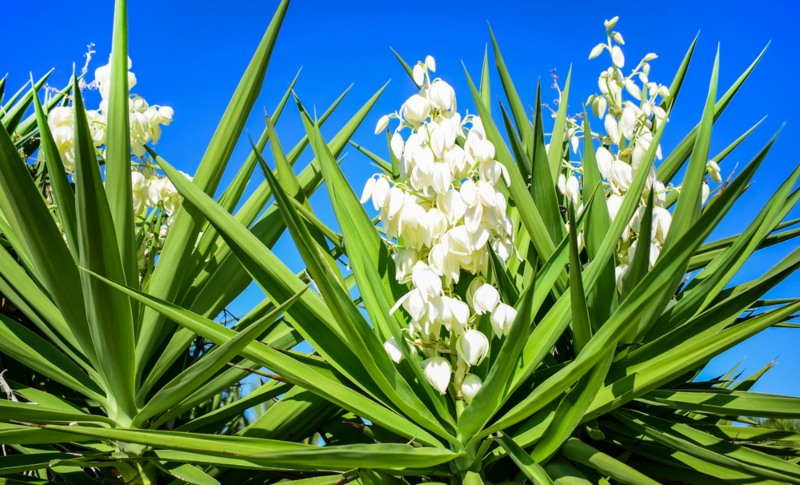Yucca is a genus of herbaceous perennial trees, shrubs, and smaller plants that encompasses some 40-50 known species.

All of these species are native to the arid regions of the Americas and the Caribbean isles and can be found growing in a wide range of locales, from deserts to grasslands to rocky coastlines.
Most varieties of yucca are identifiable by their rosette structure (circular arrangements of foliage radiating outward from a central stem), tough, blade-shaped leaves, and towering panicles of white or cream-colored flowers. Some, like Joshua Tree and Spanish Bayonet, have long, woody trunks, similar to those found on palms. Others resemble scrubby desert plants of similar sizes, such as cacti, agave, and dasylirion.
Like other desert plants, yucca thrives in hot, dry conditions. Owing to these preferences, it’s typically grown outdoors in mild temperate or subtropical climates, where it is assured ample sunlight, warmth, sandy soil, and other elements crucial for its survival. However, some types of yucca are suitable for cultivating inside the home, the most common being Yucca gigantea, Yucca filamentosa, and Yucca elephantipes.

| Botanical Name: | Yucca |
| Common Name(s): | Adam’s Needle, Aloe Yucca, Dagger Plant, Joshua Tree, Narrowleaf Yucca, Needle Palm, Spanish Bayonet |
| Plant Type: | Perennial shrubs/trees |
| Mature Size: | Variable; shrubs usually 2-4 feet tall and wide, while larger trees can reach up to 30 feet in height |
| Sun Exposure: | Full sun |
| Water Needs: | Minimal |
| Soil Type: | Sandy, well-drained soil |
| Soil pH: | Neutral to slightly acidic |
| Bloom Time: | Variable; most often spring or mid-to-late summer |
| Maintenance: | Low |
| Flower Color: | White or off-white |
| Hardiness Zones: | 5-11, depending on species |
| Toxicity: | Moderately toxic to dogs, cats, and humans |
Light
Yucca favors bright, direct sunlight. It can also make do with partial or filtered sun quite well. If you’re caring for a yucca plant indoors, situate it in a south-facing window or open room with lots of natural illumination. Ideally, your yucca should receive no less than four hours of sun exposure per day. More light is generally better, but there is such a thing as too much—crispy brown leaf tips and speckled white discoloration are tell-tale signs of sun damage.

Water
Being a desert plant, yucca is impressively drought-resistant and can easily go weeks without a drop of water. That said, it will fare best when watered about once a week during its peak growing season in the spring and summer. Add roughly one inch of water to your plant’s container at a time and make sure the soil has time to dry out completely before subsequent waterings. Letting your soil remain too damp for too long can hinder your plant’s chances of survival.
Temperature & Humidity
As mentioned, yucca is happiest wherever it’s hot and dry. Indoor growers should therefore aim to maintain a hospitable environment no cooler than around 65. Outdoor horticulturists will have the best results in zones 9-11, though many have had success raising yucca in climates as cool and moist as zones 5-8. Despite its ecological inclinations, yucca is remarkably resilient in cold (but not wet) conditions and is hardy enough to overwinter without much trouble in temperate climates.
Soil
Yucca springs up naturally in loose, sandy soil. You’re welcome to use an ordinary potting or gardening mix to establish your plant, provided it offers adequate drainage. To this end, you might see fit to work in a small amount of sand, perlite, pea gravel, or another drainage-promoting amendment.
Your soil mixture must be capable of drying out quickly, as all species of yucca are highly sensitive to over-watering.
Fertilizer
In most cases, it’s not strictly necessary to fertilize yucca. Should you elect to, however, be sure to choose a well-balanced liquid of controlled-release fertilizer and get in the habit of feeding your plant once a month during its growing season. The simplest way to keep up with a fertilizing schedule is to time your feedings to coincide with every fourth or fifth watering. Pause your feedings in the fall and winter when the plant goes dormant.

Propagation
There are two different methods for propagating yucca: separating and potting the burgeoning rhizomes (also called “pups”) or cutting the plant in half and replanting the entire upper portion. For the former method, remove the pups as soon as they turn green and place them in their own containers. For the latter, pick out a roomy container or open section of your garden bed to ensure that the plant has plenty of room to spread out as it grows.
Pruning
Pruning a yucca can be a bit of a project. The simplest way to downsize an overgrown specimen is to wait until it emerges from dormancy in early spring and use a small hand saw or strong pair of loppers to cut it in half at the stem or nucleus of stems. You can then care for the truncated plant as you normally would. As it resumes growing, it will gradually fill out and regain its original shape.
Is Yucca Toxic?
While many parts of yucca plants are prized for their culinary applications—including the leaves, fruits, seeds, and roots—uncooked yucca (in particular the thick, syrupy sap) can be mildly toxic to dogs, cats, humans, and other mammals when ingested. It is recommended that you keep your plants safely off-limits to avoid a potential medical emergency if you have pets or young children at home whose curiosity might prompt them to taste-test unknown items.




